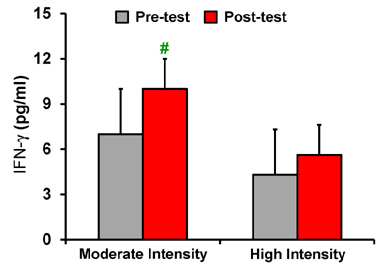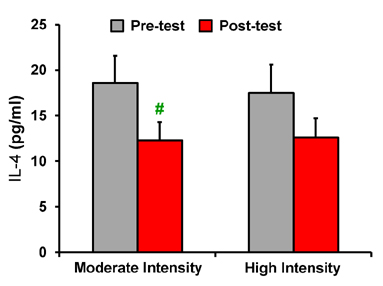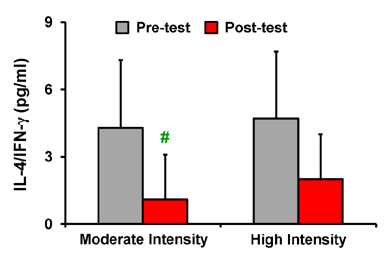Immune Netw.
2016 Apr;16(2):109-115. 10.4110/in.2016.16.2.109.
Cytokine Pattern is Affected by Training Intensity in Women Futsal Players
- Affiliations
-
- 1Department of Physical Education and Sport Science, Jahrom University, Jahrom 74135-111, Iran.
- 2SDH Research Center, Jahrom University of Medical Sciences, Jahrom 74148-46199, Iran. amoozesh.miri@yahoo.com
- 3Research Centre for Noncommunicable Diseases, Faculty of Medicine, University of Medical Sciences, Jahrom 74148-46199, Iran.
- 4Department of Exercise Science, Shiraz University, Shiraz 71946-84759, Iran.
- KMID: 2168051
- DOI: http://doi.org/10.4110/in.2016.16.2.109
Abstract
- To find the relation between exercise and cytokines, we examined the effect of the training intensity on the levels of cytokines, including interferon-gamma (IFN-γ), interlukine-4 (IL-4) and interlukine-4/interferon-gamma ratio (IL-4/IFN-γ ratio) in female Futsal players. Twelve well-trained female college Futsal players aged 19~22 participated in this study. The athletes completed 30-min of running at 60~65% maximal heart rate [moderate-intensity exercise], and 30-min of running at 75~80% maximal heart rate [high-intensity exercise]. peripheral blood samples were collected 24 h before and 24 h and 48 h after each of the exercise bouts. finding showed that The 30-min bout of moderate-intensity exercise induced a significant increase in IFN-γ (p=0.01) and significant decreases in IL-4 (p=0.001) and IL-4/IFN-γ ratio (p=0.003). And also, 30-min of running at 75~80% maximal heart rate induced increase in IFN-γ (p=0.07) and decreased in IL-4 (p=0.01) and IL-4/IFN-γ ratio (p=0.06) that these changes not significantly. In summary, exercise intensity can effect on the magnitude of changes in cytokines. It seems that moderate intensity exercise enhances cytokine pattern in female college Futsal players.
Keyword
MeSH Terms
Figure
Reference
-
1. Koch AJ. Immune Response to Exercise. Braz J Biomotricity. 2010; 2:92–93.2. Cooper DM, Radom-Aizik S, Schwindt C, Zaldivar F Jr. Dangerous exercise: lessons learned from dysregulated inflammatory responses to physical activity. J Appl Physiol (1985). 2007; 103:700–709.
Article3. Tuttle HA, Davis-Gorman G, Goldman S, Copeland JG, McDonagh PF. Proinflammatory cytokines are increased in type 2 diabetic women with cardiovascular disease. J Diabetes Complications. 2004; 18:343–351.
Article4. Moss RB, Moll T, El-Kalay M, Kohne C, Soo HW, Encinas J, Carlo DJ. Th1/Th2 cells in inflammatory disease states: therapeutic implications. Expert Opin Biol Ther. 2004; 4:1887–1896.
Article5. Abbas AK, Lichtman AH, Pillai S. Cellular and Molecular Immunology. Saunders Elsevier press;2007. p. 267–303.6. Shahabi S, Hassan ZM, Mahdavi M, Dezfouli M, Rahvar MT, Naseri M, Jazani NH. Evaluation of the neuroendocrine system and the cytokine pattern in warm and cold nature persons. Physiol Pharmacol. 2007; 11:51–59.7. Gu X, Li P, Liu H, Li N, Li S, Sakuma T. The effect of influenza virus A on th1/th2 balance and alveolar fluid clearance in pregnant rats. Exp Lung Res. 2011; 37:445–451.
Article8. Preston JA, Thorburn AN, Starkey MR, Beckett EL, Horvat JC, Wade MA, O'Sullivan BJ, Thomas R, Beagley KW, Gibson PG, Foster PS, Hansbro PM. Streptococcus pneumoniae infection suppresses allergic airways disease by inducing regulatory T-cells. Eur Respir J. 2011; 37:53–64.
Article9. Dominguez-Villar M, Baecher-Allan CM, Hafler DA. Identification of T helper type 1-like, Foxp3+ regulatory T cells in human autoimmune disease. Nat Med. 2011; 17:673–675.
Article10. Stefano G, Marco S, Federico A, Davide F, Sergio D. Exercise training lymphocyte subsets and their cytokines production: experience of an Italian professional football team and their impact on allergy. Biomed Res Int. 2014; 2014:429248.11. Sugama K, Suzuki K, Yoshitani K, Shiraishi K, Kometani T. IL-17, neutrophil activation and muscle damage following endurance exercise. Exerc Immunol Rev. 2012; 18:116–127.12. Gillum TL, Kuennen MR, Schneider S, Moseley P. A review of sex differences in immune function after aerobic exercise. Exerc Immunol Rev. 2011; 17:104–121.13. Walsh NP, Gleeson M, Shephard RJ, Gleeson M, Woods JA, Bishop NC, Fleshner M, Green C, Pedersen BK, Hoffman-Goetz L, Rogers CJ, Northoff H, Abbasi A, Simon P. Position statement Part one: Immune function and exercise. Exerc Immunol Rev. 2011; 17:6–63.14. Jahromi AS, Zar A, Ahmadi F, Krustrup P, Ebrahim K, Hovanloo F, Amani D. Effects of endurance training on the serum levels of tumour necrosis factor-alpha and interferon-gamma in sedentary men. Immune Netw. 2014; 14:255–259.
Article15. Gholamnezhad Z, Boskabady MH, Hosseini M, Sankian M, Khajavi RA. Evaluation of immune response after moderate and overtraining exercise in wistar rat. Iran J Basic Med Sci. 2014; 17:1–8.16. Sellar CM, Syrotuik DG, Field CJ, Bell GJ. The effect of dietary control and carbohydrate supplementation on the immune and hormonal responses to rowing exercise. Appl Physiol Nutr Metab. 2006; 31:588–596.
Article17. Alvandi H, Salehzadeh K, Najafzade MR, Taheri Kalani A. The effect of strength training on anti-inflammatory cytokines, cortisol and testosterone in overweight men. Euro J Exp Bio. 2014; 4:296–302.18. Alberti S, Cevenini E, Ostan R, Capri M, Salvioli S, Bucci L, Ginaldi L, De MM, Franceschi C, Monti D. Age-dependent modifications of Type 1 and Type 2 cytokines within virgin and memory CD4+ Tcellsinhumans. Mech Ageing Dev. 2006; 127:560–566.
Article19. Ogawa K, Oka J, Yamakawa J, Higuchi M. Habitual exercise did not affect the balance of type 1 and type 2 cytokines in elderly people. Mech Ageing Dev. 2003; 124:951–956.
Article20. Xiang L, Rehm KE, Marshall GD Jr. Effects of strenuous exercise on Th1/Th2 gene expression from human peripheral blood mononuclear cells of marathon participants. Mol Immunol. 2014; 60:129–134.
Article21. Schreiber GH, Schreiber RD. Interferon-gamma. In : Angus W, Thompson A, Lotze MT, editors. The Cytokine Handbook. 4th ed. Academic Press;2003. p. 567–601.22. Franchimont D, Galon J, Gadina M, Visconti R, Zhou Y, Aringer M, Frucht DM, Chrousos GP, O'Shea JJ. Inhibition of Th1 immune response by glucocorticoids: dexamethasone selectively inhibits IL-12-induced Stat4 phosphorylation in T lymphocytes. J Immunol. 2000; 164:1768–1774.
Article23. Nieman DC. Immune response to heavy exertion. J Appl Physiol (1985). 1997; 82:1385–1394.
Article24. Prokopchuk O, Liu Y, Wang L, Wirth K, Schmidtbleicher D, Steinacker JM. Skeletal muscle IL-4, IL-4Ralpha, IL-13 and IL-13Ralpha1 expression and response to strength training. Exerc Immunol Rev. 2007; 13:67–75.25. Jacquemin V, Butler-Browne GS, Furling D, Mouly V. IL-13 mediates the recruitment of reserve cells for fusion during IGF-1-induced hypertrophy of human myotubes. J Cell Sci. 2007; 120:670–681.
Article26. De la Fuente M, Hernanz A, Vallejo MC. The immune system in the oxidative stress conditions of aging and hypertension: favorable effects of antioxidants and physical exercise. Antioxid Redox Signal. 2005; 7:1356–1366.
Article27. Suzuki K, Nakaji S, Kurakake S, Totsuka M, Sato K, Kuriyama T, Fujimoto H, Shibusawa K, Machida K, Sugawara K. Exhaustive exercise and type-1/type-2 cytokine balance with special focus on interleukin-12 p40/p70. Exerc Immunol Rev. 2003; 9:48–57.28. Cannon JG. Inflammatory cytokines in nonpathological states. News Physiol Sci. 2000; 15:298–303.
Article29. Das UN. Anti-inflammatory nature of exercise. Nutrition. 2004; 20:323–326.
Article30. Petersen AM, Pedersen BK. The anti-inflammatory effect of exercise. J Appl Physiol (1985). 2005; 98:1154–1162.
Article31. Hirose L, Nosaka K, Newton M, Laveder A, Kano M, Peake J, Suzuki K. Changes in inflammatory mediators following eccentric exercise of the elbow flexors. Exerc Immunol Rev. 2004; 10:75–90.32. Malm C, Sjodin TL, Sjoberg B, Lenkei R, Renstrom P, Lundberg IE, Ekblom B. Leukocytes, cytokines, growth factors and hormones in human skeletal muscle and blood after uphill or downhill running. J Physiol. 2004; 556:983–1000.
Article33. Toft AD, Jensen LB, Bruunsgaard H, Ibfelt T, Halkjaer-Kristensen J, Febbraio M, Pedersen BK. Cytokine response to eccentric exercise in young and elderly humans. Am J Physiol Cell Physiol. 2002; 283:C289–C295.34. Suzuki K, Yamada M, Kurakake S, Okamura N, Yamaya K, Liu Q, Kudoh S, Kowatari K, Nakaji S, Sugawara K. Circulating cytokines and hormones with immunosuppressive but neutrophil-priming potentials rise after endurance exercise in humans. Eur J Appl Physiol. 2000; 81:281–287.
Article35. Huffman KM, Slentz CA, Bales CW, Houmard JA, Kraus WE. Relationships between adipose tissue and cytokine responses to a randomized controlled exercise training intervention. Metabolism. 2008; 57:577–583.
Article36. Chikanza IC, Grossman AB. Reciprocal interactions between the neuroendocrine and immune systems during inflammation. Rheum Dis Clin North Am. 2000; 26:693–711.
Article37. Saitoh M, Yanagawa T, Kondoh T, Miyakoda H, Kotake H, Mashiba H. Neurohumoral factor responses to mental (arithmetic) stress and dynamic exercise in normal subjects. Intern Med. 1995; 34:618–622.
Article38. Elenkov IJ, Wilder RL, Chrousos GP, Vizi ES. The sympathetic nerve—an integrative interface between two supersystems: the brain and the immune system. Pharmacol Rev. 2000; 52:595–638.39. Kidd P. Th1/Th2 balance: the hypothesis, its limitations, and implications for health and disease. Altern Med Rev. 2003; 8:223–246.40. Singh T, Newman AB. Inflammatory markers in population studies of aging. Ageing Res Rev. 2011; 10:319–329.
Article41. Izquierdo M, Ibanez J, Calbet JA, Navarro-Amezqueta I, Gonzalez-Izal M, Idoate F, Hakkinen K, Kraemer WJ, Palacios-Sarrasqueta M, Almar M, Gorostiaga EM. Cytokine and hormone responses to resistance training. Eur J Appl Physiol. 2009; 107:397–409.
Article42. Suzuki K, Nakaji S, Yamada M, Totsuka M, Sato K, Sugawara K. Systemic inflammatory response to exhaustive exercise: cytokine kinetics. Exerc Immunol Rev. 2000; 8:6–48.43. Ho CS, Lopez JA, Vuckovic S, Pyke CM, Hockey RL, Hart DN. Surgical and physical stress increases circulating blood dendritic cell counts independently of monocyte counts. Blood. 2001; 98:140–145.
Article44. Upham JW, Lundahl J, Liang H, Denburg JA, O'Byrne PM, Snider DP. Simplified quantitation of myeloid dendritic cells in peripheral blood using flow cytometry. Cytometry. 2000; 40:50–59.
Article45. Lancaster GI, Khan Q, Drysdale PT, Wallace F, Jeukendrup AE, Drayson MT, Gleeson M. Effect of prolonged exercise and carbohydrate ingestion on type 1 and type 2 T lymphocyte distribution and intracellular cytokine production in humans. J Appl Physiol (1985). 2005; 98:565–571.
Article46. Blotta MH, DeKruyff RH, Umetsu DT. Corticosteroids inhibit IL-12 production in human monocytes and enhance their capacity to induce IL-4 synthesis in CD4+ lymphocytes. J Immunol. 1997; 158:5589–5595.47. Pedersen BK, Rohde T, Ostrowski K. Recovery of the immune system after exercise. Acta Physiol Scand. 1998; 162:325–332.
Article48. Calcagni E, Elenkov I. Stress system activity, innate and T helper cytokines, and susceptibility to immune-related diseases. Ann N Y Acad Sci. 2006; 1069:62–76.
Article49. Lancaster GI, Halson SL, Khan Q, Drysdale P, Wallace F, Jeukendrup AE, Drayson MT, Gleeson M. Effects of acute exhaustive exercise and chronic exercise training on type 1 and type 2 T lymphocytes. Exerc Immunol Rev. 2004; 10:91–106.
- Full Text Links
- Actions
-
Cited
- CITED
-
- Close
- Share
- Similar articles
-
- Common Sports Injuries among National Players in Korea
- The Experience of the Upper Respiratory Infection of the Elite Winter Sports Athletes and Its Effect on Training and Competition
- Food Habits and Serum Lipid Concentratons during the Periods of Training and Detraining in Volleyball Players
- The Effect of Coordinative Locomotor Training Using Elastic Bands on the Flexibility and Body Alignment of Elementary School Right-Handed Baseball Players
- The Comparison of Psychological Characteristics between Korean and Japanese Women Pro-Basketball Players




